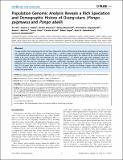Files in this item
Population genomic analysis reveals a rich speciation and demographic history of orang-utans (Pongo pygmaeus and Pongo abelii)
Item metadata
| dc.contributor.author | Ma, Xin | |
| dc.contributor.author | Kelley, Joanna L. | |
| dc.contributor.author | Eilertson, Kirsten | |
| dc.contributor.author | Musharoff, Shaila | |
| dc.contributor.author | Degenhardt, Jeremiah D. | |
| dc.contributor.author | Martins, André L. | |
| dc.contributor.author | Vinar, Tomas | |
| dc.contributor.author | Kosiol, Carolin | |
| dc.contributor.author | Siepel, Adam | |
| dc.contributor.author | Gutenkunst, Ryan N. | |
| dc.contributor.author | Bustamante, Carlos D. | |
| dc.date.accessioned | 2017-02-09T15:30:12Z | |
| dc.date.available | 2017-02-09T15:30:12Z | |
| dc.date.issued | 2013-10-23 | |
| dc.identifier | 249098879 | |
| dc.identifier | 387795ea-53df-4042-a5fd-9411b2175cca | |
| dc.identifier | 24194868 | |
| dc.identifier | 84886042608 | |
| dc.identifier.citation | Ma , X , Kelley , J L , Eilertson , K , Musharoff , S , Degenhardt , J D , Martins , A L , Vinar , T , Kosiol , C , Siepel , A , Gutenkunst , R N & Bustamante , C D 2013 , ' Population genomic analysis reveals a rich speciation and demographic history of orang-utans ( Pongo pygmaeus and Pongo abelii ) ' , PLoS One , vol. 8 , no. 10 , e77175 . https://doi.org/10.1371/journal.pone.0077175 | en |
| dc.identifier.issn | 1932-6203 | |
| dc.identifier.other | PubMedCentral: PMC3806739 | |
| dc.identifier.uri | https://hdl.handle.net/10023/10263 | |
| dc.description.abstract | To gain insights into evolutionary forces that have shaped the history of Bornean and Sumatran populations of orang-utans, we compare patterns of variation across more than 11 million single nucleotide polymorphisms found by previous mitochondrial and autosomal genome sequencing of 10 wild-caught orang-utans. Our analysis of the mitochondrial data yields a far more ancient split time between the two populations (~3.4 million years ago) than estimates based on autosomal data (0.4 million years ago), suggesting a complex speciation process with moderate levels of primarily male migration. We find that the distribution of selection coefficients consistent with the observed frequency spectrum of autosomal non-synonymous polymorphisms in orang-utans is similar to the distribution in humans. Our analysis indicates that 35% of genes have evolved under detectable negative selection. Overall, our findings suggest that purifying natural selection, genetic drift, and a complex demographic history are the dominant drivers of genome evolution for the two orang-utan populations. | |
| dc.format.extent | 11 | |
| dc.format.extent | 826251 | |
| dc.language.iso | eng | |
| dc.relation.ispartof | PLoS One | en |
| dc.subject | QH301 Biology | en |
| dc.subject | QH426 Genetics | en |
| dc.subject.lcc | QH301 | en |
| dc.subject.lcc | QH426 | en |
| dc.title | Population genomic analysis reveals a rich speciation and demographic history of orang-utans (Pongo pygmaeus and Pongo abelii) | en |
| dc.type | Journal article | en |
| dc.contributor.institution | University of St Andrews. School of Biology | en |
| dc.contributor.institution | University of St Andrews. Centre for Biological Diversity | en |
| dc.identifier.doi | 10.1371/journal.pone.0077175 | |
| dc.description.status | Peer reviewed | en |
This item appears in the following Collection(s)
Items in the St Andrews Research Repository are protected by copyright, with all rights reserved, unless otherwise indicated.

